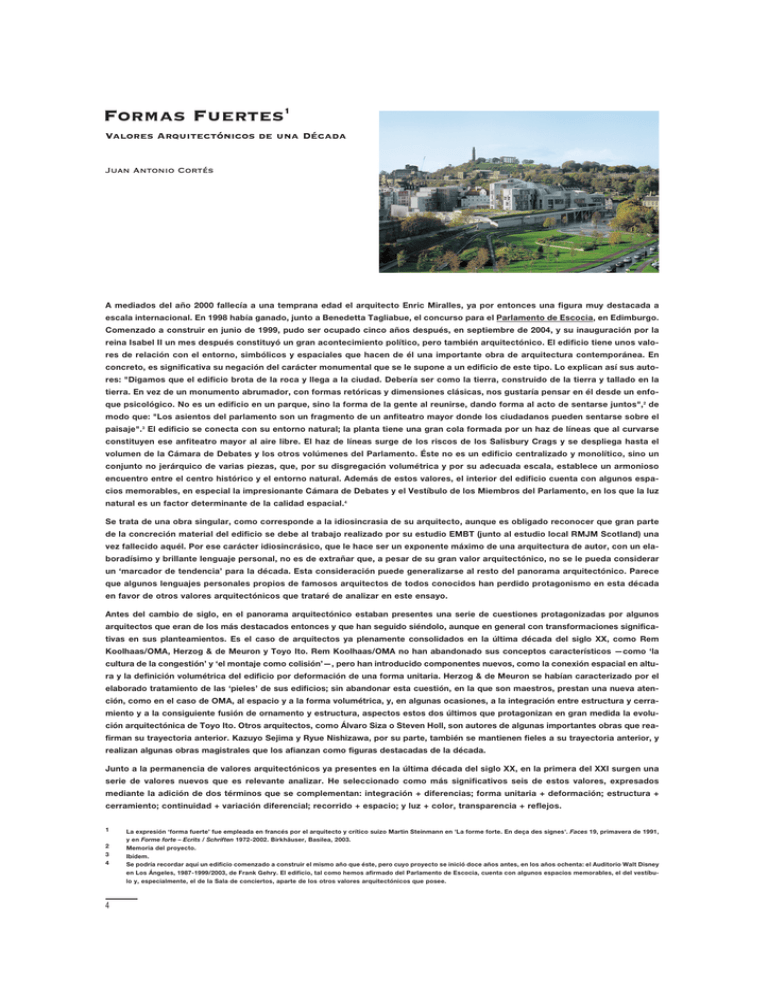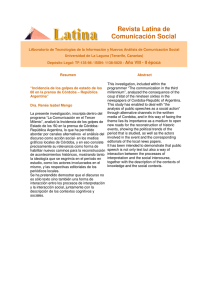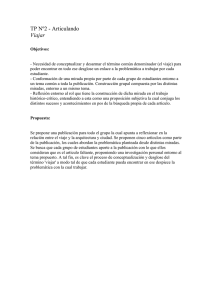Formas Fuertes
Anuncio

Formas Fuertes1 Valores Arquitectónicos de una Década Juan Antonio Cortés A mediados del año 2000 fallecía a una temprana edad el arquitecto Enric Miralles, ya por entonces una figura muy destacada a escala internacional. En 1998 había ganado, junto a Benedetta Tagliabue, el concurso para el Parlamento de Escocia, en Edimburgo. Comenzado a construir en junio de 1999, pudo ser ocupado cinco años después, en septiembre de 2004, y su inauguración por la reina Isabel II un mes después constituyó un gran acontecimiento político, pero también arquitectónico. El edificio tiene unos valores de relación con el entorno, simbólicos y espaciales que hacen de él una importante obra de arquitectura contemporánea. En concreto, es significativa su negación del carácter monumental que se le supone a un edificio de este tipo. Lo explican así sus autores: "Digamos que el edificio brota de la roca y llega a la ciudad. Debería ser como la tierra, construido de la tierra y tallado en la tierra. En vez de un monumento abrumador, con formas retóricas y dimensiones clásicas, nos gustaría pensar en él desde un enfoque psicológico. No es un edificio en un parque, sino la forma de la gente al reunirse, dando forma al acto de sentarse juntos",2 de modo que: "Los asientos del parlamento son un fragmento de un anfiteatro mayor donde los ciudadanos pueden sentarse sobre el paisaje".3 El edificio se conecta con su entorno natural; la planta tiene una gran cola formada por un haz de líneas que al curvarse constituyen ese anfiteatro mayor al aire libre. El haz de líneas surge de los riscos de los Salisbury Crags y se despliega hasta el volumen de la Cámara de Debates y los otros volúmenes del Parlamento. Éste no es un edificio centralizado y monolítico, sino un conjunto no jerárquico de varias piezas, que, por su disgregación volumétrica y por su adecuada escala, establece un armonioso encuentro entre el centro histórico y el entorno natural. Además de estos valores, el interior del edificio cuenta con algunos espacios memorables, en especial la impresionante Cámara de Debates y el Vestíbulo de los Miembros del Parlamento, en los que la luz natural es un factor determinante de la calidad espacial.4 Se trata de una obra singular, como corresponde a la idiosincrasia de su arquitecto, aunque es obligado reconocer que gran parte de la concreción material del edificio se debe al trabajo realizado por su estudio EMBT (junto al estudio local RMJM Scotland) una vez fallecido aquél. Por ese carácter idiosincrásico, que le hace ser un exponente máximo de una arquitectura de autor, con un elaboradísimo y brillante lenguaje personal, no es de extrañar que, a pesar de su gran valor arquitectónico, no se le pueda considerar un ‘marcador de tendencia’ para la década. Esta consideración puede generalizarse al resto del panorama arquitectónico. Parece que algunos lenguajes personales propios de famosos arquitectos de todos conocidos han perdido protagonismo en esta década en favor de otros valores arquitectónicos que trataré de analizar en este ensayo. Antes del cambio de siglo, en el panorama arquitectónico estaban presentes una serie de cuestiones protagonizadas por algunos arquitectos que eran de los más destacados entonces y que han seguido siéndolo, aunque en general con transformaciones significativas en sus planteamientos. Es el caso de arquitectos ya plenamente consolidados en la última década del siglo XX, como Rem Koolhaas/OMA, Herzog & de Meuron y Toyo Ito. Rem Koolhaas/OMA no han abandonado sus conceptos característicos —como ‘la cultura de la congestión’ y ‘el montaje como colisión’—, pero han introducido componentes nuevos, como la conexión espacial en altura y la definición volumétrica del edificio por deformación de una forma unitaria. Herzog & de Meuron se habían caracterizado por el elaborado tratamiento de las ‘pieles’ de sus edificios; sin abandonar esta cuestión, en la que son maestros, prestan una nueva atención, como en el caso de OMA, al espacio y a la forma volumétrica, y, en algunas ocasiones, a la integración entre estructura y cerramiento y a la consiguiente fusión de ornamento y estructura, aspectos estos dos últimos que protagonizan en gran medida la evolución arquitectónica de Toyo Ito. Otros arquitectos, como Álvaro Siza o Steven Holl, son autores de algunas importantes obras que reafirman su trayectoria anterior. Kazuyo Sejima y Ryue Nishizawa, por su parte, también se mantienen fieles a su trayectoria anterior, y realizan algunas obras magistrales que los afianzan como figuras destacadas de la década. Junto a la permanencia de valores arquitectónicos ya presentes en la última década del siglo XX, en la primera del XXI surgen una serie de valores nuevos que es relevante analizar. He seleccionado como más significativos seis de estos valores, expresados mediante la adición de dos términos que se complementan: integración + diferencias; forma unitaria + deformación; estructura + cerramiento; continuidad + variación diferencial; recorrido + espacio; y luz + color, transparencia + reflejos. 1 2 3 4 4 La expresión ‘forma fuerte’ fue empleada en francés por el arquitecto y crítico suizo Martin Steinmann en 'La forme forte. En deça des signes'. Faces 19, primavera de 1991, y en Forme forte – Ecrits / Schriften 1972-2002. Birkhäuser, Basilea, 2003. Memoria del proyecto. Ibídem. Se podría recordar aquí un edificio comenzado a construir el mismo año que éste, pero cuyo proyecto se inició doce años antes, en los años ochenta: el Auditorio Walt Disney en Los Ángeles, 1987-1999/2003, de Frank Gehry. El edificio, tal como hemos afirmado del Parlamento de Escocia, cuenta con algunos espacios memorables, el del vestíbulo y, especialmente, el de la Sala de conciertos, aparte de los otros valores arquitectónicos que posee. Strong Forms1 Architectural Values of a Decade Juan Antonio Cortés Architect Enric Miralles passed away midway through the year 2000 at an early age, already a widely renowned figure on the international stage. In 1998, he won the competition for the Scottish Parliament in Edinburgh with Benedetta Tagliabue. Begun in June 1999, it was ready for occupation five years later, in September 2004, and its official opening by Queen Elizabeth II in the following month was a momentous political and also architectural event. This building embodies symbolic, spatial and other values concerning relationships with the environment that make this an important work of contemporary architecture. In particular, it embodies a significant denial of the monumental character that a building of this type is supposed to have. The authors explain, "Let us say that the building bubbles up from the rock and enters the city. It should be like the earth, built from the earth and carved into the earth. Instead of being an overawing monument, with rhetorical forms and classic dimensions, we would regard it from a psychological perspective. It is not a building in a park, but rather the form of people when they gather, shaping the act of sitting together", 2 in such a way that, "The seats in the Parliament are a fragment of a larger amphitheatre where citizens can sit in the landscape" 3. The building is connected to its natural environment, the plan has a long tail shaped by a bundle of lines which curve to form the larger outdoor amphitheatre. This bundle of lines emerges from Salisbury Crags, extending to the Debating Chamber and the other Parliament volumes. This is a non-hierarchical set of pieces, not a centralized, monolithic building. Their volumetric breakdown and their appropriate scale create a harmonious encounter between Edinburgh’s historic district and the natural surroundings. In addition to these values, the interior contains several memorable spaces, especially the impressive Debating Chamber and the Members’ Lobby, where the natural light makes a decisive impact on the quality of the space. 4 This is a singular work of architecture, as befits Miralles’ idiosyncrasy, although it must be remembered that many of the building’s physical details were resolved after his death by his studio EMBT, in conjunction with the local office, RMJM Scotland. The idiosyncratic nature of this work makes it a major exponent of original, authored architecture with a brilliant, highly elaborate personal language, so it is not surprising that despite its great architectural value, it cannot be regarded as a ‘trendsetter’ for the rest of the decade. This observation can be extended to the rest of the architectural scene. During the decade, the distinctive personal languages of famous architects seem to have lost prominence to the benefit of other architectural values discussed in this essay. Before the turn of the century, several issues on the architectural scene were predominated by some of the most prominent architects both then and now, although most have undergone significant changes in their approaches. This is the case of fully consolidated architects in the final decade of the 20th century, such as Rem Koolhaas/OMA, Herzog & de Meuron, and Toyo Ito. Rem Koolhaas/OMA have not abandoned their characteristic concepts —’culture of congestion’ and ‘collision montage’—, but they have included new components such as vertical spatial connections and the volumetric definition of a building via the deformation of a unitary form. Herzog & de Meuron were already known for the elaborate treatment of their buildings’ ‘skins’. Without abandoning this aspect, in which they are masters, they now have a new focus, as with OMA, on space and volumetric form, and in some cases the integration between structure and enclosure and the resulting merger of ornament and structure. The latter two aspects are a substantial part of Toyo Ito’s architectural evolution. Other architects such as Alvaro Siza and Steven Holl have authored several important works that reaffirm their previous paths, while Kazuyo Sejima and Ryue Nishizawa have also remained faithful to their line, with several masterworks that confirm their status as prominent figures in the decade. While many architectural values already present in the last decade of the 20th century continued to make their presence felt in the first decade of the 21st century, we must also analyze new values that emerged in this period. I have chosen six of what I think are the most significant values, expressed by the addition of two mutually complementary terms: integration + differences, unitary form + deformation, structure + enclosure, continuity + differential variation, route + space, and light + colour, transparency + reflections. 1 2 3 4 5 The expression ‘strong form’ was used in French by the Swiss architect and critic Martin Steinmann in 'La forme forte. En deça des signes'. Faces 19, Spring 1991, and in Forme forte — Ecrits/Schriften 1972-2002. Birkhäuser, Basel, 2003. Project summary. Ibidem. One building that comes to mind here is the Walt Disney Concert Hall in Los Angeles, 1987-1999/2003, by Frank Gehry, which began construction in the same year although the project dates back twelve years earlier. Like the Scottish Parliament, this building contains several memorable spaces like the lobby and, especially, the Concert Hall, in addition to its other architectural values.


